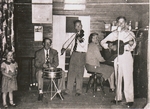Judging from historical references, occurrences in the repertoires of traditional fiddlers, and comments made by documented musicians, a great many British, Canadian, and American fiddle tunes found in neighboring New England also have circulated in the Adirondacks, though some played with much greater frequency than others (see Some Background page for reasons why, and tune examples that include some established “standards”).
Most
fiddlers revere the dance related and other tunes they have learned and play,
attempting to render them  faithfully from one performance to the next. For “ear
players” especially, namely those instrumentalists who do not read scored tunes
set down on the handwritten or printed page, such musical artifacts are quite
literally an acquired aural inheritance.
faithfully from one performance to the next. For “ear
players” especially, namely those instrumentalists who do not read scored tunes
set down on the handwritten or printed page, such musical artifacts are quite
literally an acquired aural inheritance.
Unfortunately, there is no easy determination of precisely which, and just how many, tradition-indebted fiddle tunes figure into an accounting of “standards” in “localized” Adirondack tradition--let alone inclusive of “local tunes” of limited distribution considered in the mix. Titles alone for tunes, in absence of actual tune strains, can be misleading. Very complex processes of aural circulation, together with sometimes subtle individual creativity, have resulted in countless tune strain and tune phrase variations over time and across space.
Additionally, parts of established tunes now and then become fused, consciously or unconsciously, with other tunes in what might be called “melodic attraction.” Both idiosyncratic and imitated string tunings, bowing practices, and fingerings (contributing to all sorts of improvised-in-performance tune “ornamentation”) further complicate matters in attempts to gauge derivation indebtedness and tune relatives.
The
tunes included in this section represent performers whose materials and
renditions suggest some of the variety that make for “Local Fiddle & Dance
Tunes” however determined.
Tunes:
- Johnson Pond – Anonymous (No Audio File)


